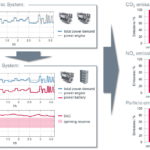MAN Diesel & Turbo shows its optimization tool for hybrid systems – with a load profile and a comparison of the resulting conventional as well as battery-hybrid. Positive use cases for battery-hybrid systems are given not only for commonly referenced applications such as ferries but many further applications as well
As IMO indicated in its third greenhouse gases study (2014), total shipping accounts for approximately 2.5% of the overall greenhouse[ds_preview] gases in 2012. Furthermore, marine-related CO2 emissions are projected to increase significantly in the future scenarios due to growing sea trade.
Battery-hybrid systems are a promising new technological approach to mitigate the emissions increase in the marine sector and ultimately contribute to the vision of a CO2-neutreal world. The energy storage system acts as spinning reserve and peak shaving entity to optimize the engine operating point. It can furthermore improve emissions during transient engine behavior at high load steps or during start-up. Moreover, especially local emissions in emission control areas can be tremendously reduced by battery only mode and cold ironing at harbors enabling emissions free operation.
As shore connections to recharge battery systems are still rare, batteries are mainly recharged by the onboard engines. This results in the need for an optimized sizing of engines and batteries based on load profiles in order to achieve an economically and environmentally beneficial hybrid system. In that, the overall system architecture as well as the parameters defining the individual components such as efficiency curves and aging behavior have to be taken into account. Considerations can either be focused individually on the propulsion power or the hotel load, or on optimizing the overall energy supply system.
Figure 1 shows the structure of MAN Diesel & Turbo’s optimization tool. Next to component data such as battery aging or the engine efficiency profile as well as the system topology (diesel-mechanic/electric, ac-grid/dc-grid, …) are handed over as input parameter. Moreover, the operating strategy is defined depending on the particular power profile. Based on an initial component sizing, the load is ideally distributed among engines and battery on a given route in order to minimize emissions and costs. In that, operation and maintenance as well as battery aging are taken into account. The overall optimized system configuration is derived by adapting the system configuration with regard to e.g. amount of cylinders, battery size or battery operating window in the loop.
The hotel load of a bulker during harbor operation is investigated to highlight the achievable saving potential of a hybrid system. A corresponding load profile and a comparison of the resulting conventional as well as battery-hybrid system are shown in figure 2. The conventional diesel-mechanic system consists of three 5L23/30H auxiliary engines, each delivering 710 kW in an n+1 configuration. Thus, two engines are running on average at a part load of only 43%. Maintaining an n+1 configuration also for the battery-hybrid system, the average load of the running engines increases to 85% with the battery system acting as spinning reserve and peak shaving entity. The state-of-charge of the 0.38 MWh battery system only varies in the range of 73 to 86% during peak shaving and thus a sufficient spinning reserve can be guaranteed at all times. This further allows running on one engine only. Reducing the number of the required engines by one with regard to initial installation and maintenance, results in a commercially and from the emissions point of view beneficial system configuration.
The given example shows that positive use cases for battery-hybrid systems are given not only for commonly referenced applications such as ferries but many further applications as well. A detailed investigation of the overall energy demand can result in reduced emissions and positive business cases in all areas of shipping and is the base for a successful transition of the sector.
Susanne Lehner, Carina Dormann, Alexander Knafl

















